Rachel Deffenbaugh
The Power of Prevention in the Pregnancy Help Movement
by Lori Kuykendall, President of Beacon Health Education Resources
Planned Parenthood boasts itself to be the largest provider of sex education. Given their business model of providing abortions (and now the second largest provider of puberty blockers and cross-sex hormones), it makes sense that they would want greater access to students through sex “education” in schools and community groups. Those students are potential clients. If they follow their “comprehensive sex education” guidance to use condoms and/or birth control, they will eventually need their contraception services, STI testing and treatment, and tragically too often, abortion.
I was hired by Women’s Pregnancy Center in 1995 as the Teen Outreach Director. The new position was created by the Board and directors who said, “We want to reach the girls before they need us.” God had given them a clear calling to go out to local schools, churches, and community groups with a prevention program. I was a new college graduate with a degree in health education and a calling to full-time missions. God answered all our prayers, and we got to work!
Developing Our Calling
Too many clients were sharing comments like “No one ever told me that…” or “We thought we wouldn’t get pregnant if we…” or “We had sex by accident.” Too many didn’t know God’s good plan for sexual integrity nor the dangers of sex outside that plan. In response, we developed a medically accurate, age-appropriate program for public schools and a faith-based version for churches and private schools.
Many centers, like Women’s Pregnancy Center, have felt a calling and the capacity to offer prevention programs to help address the abortion issue further “upstream.” Many are now active in area schools, churches, and community groups sharing a clear message of abstinence-until-marriage, or what is called Sexual Risk Avoidance (SRA) or Optimal Health Education. Some centers develop their research-based programs and others use national curriculum.
About the Curriculum
Prevention/SRA programs share life-giving truths about the risks of pregnancy, sexually transmitted diseases, and the emotional risks of nonmarital sexual activity. They present the miracle of life and fetal development. They encourage positive character development, healthy relationships, and respect for the inherent value of every person. Effective programs deliver clear messages using trained, relevant presenters and help to establish a community of support for making the healthiest decisions for physical, mental, emotional, social, and spiritual health.
The Tremendous Impact of Prevention/SRA Programs
Heartbeat’s vision is “to make abortion unwanted today and unthinkable for future generations.” When we help prevent crisis pregnancies among young people through clear guidance away from nonmarital sex, we are reducing abortion among that population. When we teach a classroom of teens about fertilization and the earliest days of development, we are making abortion less wanted and life more evident. My favorite benefit is the long-term one: when we are helping young people save sex for marriage, we are strengthening those marriages and their future families and having a strong, healthy impact on future generations.
There is great power in prevention for pregnancy help centers. If your center is already active in this space, stay trained and advocate well for SRA programs in your community. If your center is considering prevention outreach, keep an eye out on our Live Virtual Classes page in the Heartbeat Academy. Watch for an announcement of the next possible online course; "Prevention and Community Outreach for Pregnancy Help Centers” is in session now and may be offered again at a future date. And if your center is not feeling the call or capacity to do so, look for other organizations in your area who are and explore ways to partner.
Option Line - Call Connections

*Names have been changed for privacy.
Option Line is free to Heartbeat International affiliates.
Click here to learn all of the benefits of being an affiliate! If you would like to become an affiliate, simply click here to get started.
The Importance of Keeping Stats
A few years ago, a donor asked Ellen Foell, International Program Specialist for Heartbeat International, for the metrics of an international pregnancy center affiliate in Israel. This sparked a conversation with the pregnancy center, Be'ad Chaim, about what donors look for before giving to an organization. After sharing some tools with their National Director, Sandy Shoshani, she thoughtfully put together this video.
Donors Like Metrics
According to a study by Stanford Philanthropy and Civil Society, while observing donor behavior they learned that 70% of donors "tend to research their gifts." This finding is important to remember when considering what data to track based on what matters most to donors.
As you see from the video, tracking key data can be painless and seamless. As a pregnancy center, essential items that donors will look for include:
1. The number of women who call your center that want an abortion.
2. The number of women who call your center considering an abortion.
3. The number of women who call your center who just want help, and are not abortion-minded.
Click here for a template you can use to help you get started! If you find it easier to track online, make a copy of this Google template and use it for your center's calls. (Important: Make a copy of this Google form BEFORE using it.)
Back to School: Online, In-Print, or In-Person!
by Jennifer Wright, Development Editor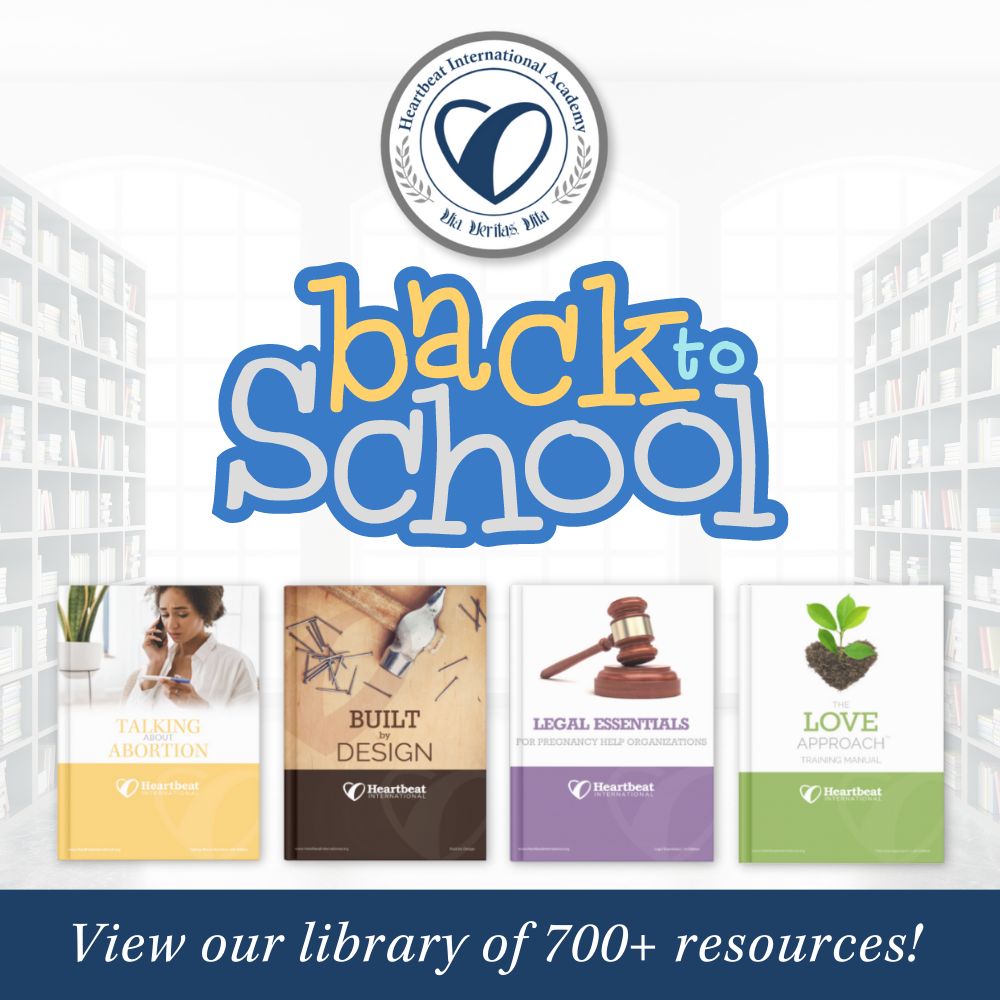
It’s that time again: back to school.
The end of summer vacation traditionally comes with groans from children and sighs of relief from parents. While the summer break was nice for me growing up, I was always a little more excited than my peers to get back to classes—from kindergarten to college!
I love the structured learning of a classroom. (It plays more to my strengths than more self-paced options!) And to this day, I’ll choose a seminar, class, or lecture over most other social opportunities. (I know, I know, I’m a total nerd!) But even if you’re not like me and still get emails about the astronomy lectures at your old college on the off chance you might be able to go to the next one, you may feel the need to do some extra learning as your kids go back to school.
Heartbeat has some fantastic opportunities year-round for ongoing education you can use every day in your organization—whether it be a pregnancy center, medical clinic, adoption agency, or maternity home! And fall is the season we like to make sure you have a variety of options that play to your strengths!
Online: Webinars, Live Virtual Classes, and Courses–Oh My!
Online learning has been growing since the internet began, and there are more and more tools available to make it better all the time.
Heartbeat is continuing to take advantage of those tools as well as the expertise of pregnancy help leaders around the world to create an educational experience like no other at Heartbeat Academy.
You’re probably familiar with our webinars and our continuing education course ConCERT. (Fun Fact: ConCERT was a mail-order course before moving online, so it’s been around a while!) But what about our increasingly common live virtual classes?
These live virtual classes are a beautiful blend of the classroom experience and the flexibility of online learning. For these classes, you have classmates working through the same content at the same time, an instructor who answers questions and presents content live, and the opportunity to join sessions from wherever suits you best. Most require about three to four hours of work (including a live session), but some classes may have different requirements. You can learn more about individual classes open for registration by clicking here. (Allow me to recommend Prevention and Community Outreach for Pregnancy Help Organizations with Lori Kuykendall. The next one starts soon!)
If you need something specific that you don’t see on the live virtual class list, try searching for the topic in our online store. That’s where you can find Advancement Boot Camp (fundraising with Kirk Walden), How to Identify & Assist Victims of Human Trafficking, and Online Ultrasound Training, not to mention courses that complement our training manuals like The LOVE Approach or Built By Design. These courses are built for you to complete at your own pace and are perfect for self-starters with limited time.
In-Print: When a Screen Won’t Cut It
I know what some of you are thinking, and no, online learning isn’t ideal for everyone. Studies continue to show that reading comprehension is better on a page than on a screen. If you need something in print to make it stick, we’ve got you covered. Our training manuals are phenomenal resources to keep on your shelf and reference as needed or work through in a training at the center. Whether you want a manual to stand alone or plan to supplement it with online options, these consistent resources are full of important information for your volunteers, Board members, medical staff, and more. New organizations and seasoned ones alike can check to see if there are any holes in their toolbox by checking the Pregnancy Help Starter Kit. Order the kit for a comprehensive set of resources or look at the contents to see if there’s anything you might be missing.
In-Person: When You Just Need to Meet a Friend
While Pregnancy Help Institute has just wrapped up and registration for the 2024 Heartbeat Conference doesn’t open for some time, there are still opportunities for training in person. Many of our affiliates take advantage of on-site consultations at least once over the course of their affiliation. Sometimes, you just need someone with expertise to come in and teach your Board how to govern effectively, work with your leadership team to create a strategic plan, or get all your client services staff and volunteers on the same page with abortion recovery or talking about abortion. For these, a Heartbeat expert comes to you!
On the other hand, sometimes it’s more efficient to bring together a group of people who need the same training all in one place at the same time. That’s why the LOVE Approach Ultrasound Clinical (held quarterly) and the Annual Conference travel across the country from training to training. We want to make travel less of a burden for our affiliates and bring you the benefit of a wide range of people coming together. We often hear that trainings like these (and Pregnancy Help Institute) hold bonus benefits like networking, making new friends, and discovering that you are not alone.
Whether you learn best online, in print, or in-person, I hope you have the chance to get back to school as summer comes to a close.
___________________________________________________________________________________
Bonus! A bonus feature we have exclusive to affiliates, Heartbeat International Academy provides the opportunity for you to take our online training materials and bring them to your staff members and volunteers in your own personalized style and format with our custom training course option. In this option, you take control of your staff member's online training by controlling enrollment, tracking progress, offering your center's own customizing training, and monitoring their activity.
Maternity Housing Coalition Partnership
by Valerie Harkins, Director of Maternity Housing Coalition
The Maternity Housing Coalition (MHC) is excited to announce three features available to Heartbeat International affiliates.
1. Announcing our new housing locator tool!
a. This tool is free to all affiliates.
b. An online application is built into the tool. With the application feature, affiliated homes receive an email with a snapshot of the potential client's information including her name, gestation, current location, and if she currently has a safe place to stay.
c. Affiliate homes are matched with a woman based on the intake information entered. When you reach out to connect with this young woman, you are already prepared with the information you need to have a successful and fruitful conversation.
2. Option Line is partnered with MHC!
a. Option Line is available 24/7, including holidays, to assist women applying for maternity housing.
3. Maternity Homes can Forward Calls to Option Line!
a. Maternity home affiliates can forward calls to Option Line after hours as a complementary benefit of affiliation. When your office is closed, even during meetings or events, Option Line is here to assist women attempting to contact your maternity home.
b. Option Line is bilingual! This gives you peace of mind knowing that even Spanish-speaking callers are being served.
c. Click here to learn how to take advantage of this benefit.
Next Step: Click here to register to be added to the housing locator tool today! We aim to create a robust directory of maternity homes where you can list your services so women can be connected and served even faster. With our partnership with Option Line, we will reach even more!
_______________________________________________________________
For questions please email This email address is being protected from spambots. You need JavaScript enabled to view it..
Help Wanted: Men in the Movement
by Mark McDougal, Development Director of Ruth Harbor Ministries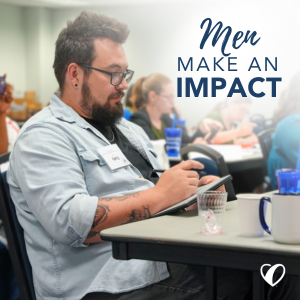
What would motivate a man to participate in the pregnancy help movement? What would motivate women to ask or encourage men to get involved?
Consider two key reasons and a few practical thoughts.
1. To Steward His Gifts
God uniquely designed us on purpose, male and female, to accomplish His purposes and the work we were called to complete (Genesis 1:27, 2:18-23). There are certainly circumstances, conversations, and tasks that are better suited for one gender over the other, but the work of the pregnancy help ministry is enormous! Thankfully, the body of Christ is diverse, and each individual is gifted to accomplish God’s work (1 Corinthians 12 and Romans 12:4-6a). We can have success utilizing less than our full potential, but why not take advantage of the entire body of Christ—His original design—when it is available to us? For instance, most single moms would suggest that parenting is more manageable and generally more successful when a dad is positively participating in their child’s life.
Biblically, the Lord has given men the role and responsibility of protection and covering for the family unit (1 Peter 3:7). The impact of a male presence should not be overlooked or underestimated. The presence of men can give a sense of safety, care, or protection. Though not exclusive to males, men make great coaches, consultants, mentors, and advisors. They round out, bring diversity, and give perspective in decision-making and to leadership staff or board.
2. To Model God’s Design
When we live out our ministry, our work, or our board life utilizing God’s design, we testify or model that design. It may seem passive, but it is an effective form of discipleship and an example for others. And since we care for more than just a decision for life, clients should see mature Christian men and how they interact with women with whom they are not romantically involved.
Many women (and men) we serve have never experienced interactions with a male who honored them, set good boundaries, and honored the Lord. This is not just an introduction to a broader view of men, but an opportunity to help female and male clients see themselves the way their heavenly Father sees them: cherished, loved, accepted, and valued. On more than one occasion, new moms impacted by our ministry have said, “I want to find a husband like ______.” (Insert name of male staff member)
Male team members can have this impact, and female staff members who are married can also encourage their husbands to be around and volunteer in appropriate ways.
Over time, affirming and healthy relationships between men—individually or as a couple/family—often yield a very positive impact; even from short encounters such as helping deliver furniture, assisting in purchasing a vehicle, taking them to church, cooking a meal, job coaching, and discussing finances, maintenance, or repairs. As we “do life” and interact with clients, they observe our interactions and relationships and begin to make comments about how it is different than what they have experienced in the past. Voila! An open door to share God's redemptive story and how it can lead them to choose something different for their future!
When a woman in trauma or abuse is experiencing an unplanned pregnancy, seeing a godly, Christian man walk out his faith, and show love and affection for his wife (and children), while biblically serving vulnerable pregnant women and their children, can be life-changing and healing for her. It's supernatural and beautiful!
And finally, a few practical thoughts:
- There are certainly some client conversations/activities that should come from women. However, if we wish to reach men, we specifically need male volunteers and staff for some conversations/activities.
- When I hear “men should rise up and participate,” most often it’s voiced by women.
- Men need to be invited to participate in the pregnancy help movement, by women AND by other men.
- Men can encourage and challenge other men in ways women can't, by encouraging them to step up to their responsibility as fathers, boyfriends, husbands, or leaders. Men can get other men involved in the movement by encouraging them to use their gifts or finances to make a difference.
- To quote some female colleagues in the pregnancy help movement, “We tend to fight less with each other when men are present.”
If you are a man who serves in pregnancy help, thank you for your commitment and impact! I encourage you to invite a male friend to your center to see the invaluable work you do.
If you are a woman who serves in pregnancy help, thank you for exercising your spiritual gifts for life! I encourage you to invite a man in your life to your center to share about the impact men can (and do) make in the pro-life movement.
___________________________________________________________
Mark McDougal served Ruth Harbor Ministries in Iowa as Executive Director for over 20 years as well as the leadership teams of Heartbeat’s Maternity Housing Coalition (MHC) and National Christian Housing Conference (NCHC). He has hired male staff team members, and couples as house parents, and typically has 50% or more male board members. He recently took a new role in their ministry as Development Director to make more time for family and consulting with other maternity homes and pregnancy centers. Contact Mark by email at This email address is being protected from spambots. You need JavaScript enabled to view it..
We Are the Champions
by Mike Spencer, Project LifeVoice
In May, I spoke at a large church in Indiana on the sacredness of human life. At one point in my message, I stated, “There are no disposable people. We are each a part of God’s plan to sanctify, or mature, one another. The unborn child diagnosed with Down syndrome and the aging parent whose mind has been ravaged by Alzheimer’s needs us, and we need them. God uses the imperfections and the neediness of others to mature us.”
Immediately after the worship service ended, a smiling young mother cradling an infant approached my wife and me and said, “Hi, my name is Dani, and I want to introduce you to my son. His name is Samuel. He has Down syndrome, and he is perfect.” It was a touching moment, and the warmth and pride with which she introduced us to her son expressed beautifully what I had just spent 35 minutes trying to convey. A Down syndrome diagnosis coupled with the often loud, intimidating voices of “enlightened” abortion activists could not suppress the maternal love of this proud mother. Dani understood what so many in our culture do not, namely that “every good and perfect gift is from above…” (James 1:17). Indeed, her little Samuel is a good and perfect gift!
This story powerfully illustrates the stark difference between the pro-life position and the “pro-choice” position. When pro-lifers gaze upon an ultrasound image of a developing child in utero, we see a fellow image-bearer who should be loved and protected, regardless of whether he or she has an extra chromosome. Conversely, abortion supporters look at that same child and see only “medical waste.” Pro-life political scientist Hadley Arkes sardonically describes these abortion enthusiasts as, “people of large natures, with sensitivities cultivated to the most exacting liberal temper, and so they are prepared to engage their sympathies for all species of hurts suffered by the mass of mankind.” (Arkes, 2022, p. 2) Unfortunately, however, their cultivated sympathies do not extend to the unborn. Although they have what Arkes describes as the “most generous reflexes” toward every politically approved victim group, they think nothing of injecting an unborn baby’s heart with a lethal dose of potassium chloride and calling it “reproductive justice.” They are to be pitied for such a morbidly defective worldview which robs them of the ability to value that which is most valuable.
Friends, contrary to the narrative that has been pressed onto us by pro-abortion politicians and Hollywood elites, we are the inclusive and tolerant ones—not them. We don’t discriminate against the weak and vulnerable or minority groups. Whether the children destroyed by abortion would have lived to become future inventors or future competitors in the Special Olympics is irrelevant. Einstein counts and so does the child with an extra chromosome.
We are the real champions of human worth and human equality. And we’ll keep on fighting to the end because like this young mother, we recognize the intrinsic and inestimable moral worth of every human being, and we consider it one of life’s greatest privileges to “speak up for those who cannot speak for themselves…” (Proverbs 31:8)
____________________________________________________________________________
Source
Hadley Arkes, Natural Rights and the Right to Choose, (New York: Cambridge University Press, 2002), p. 2
International Update: The Invitation to Pursue Unity
by Ellen Foell, International Program Specialist, Heartbeat International
 Slovenia and the Balkans Conference 2023
Slovenia and the Balkans Conference 2023
Some of us have dream jobs. I am one of those people.
As Heartbeat’s International Program Specialist, I have the privilege to interface with our 1,200+ international affiliates over Zoom and WhatsApp, at conferences and summits, and sometimes on their home turf. As someone who has the privilege to travel to different countries, one of the attendant responsibilities is learning to watch and process what I see in the context of this question: What is God doing around the world, and is there an invitation to participate?
Recently, I had the joy of attending the fifth Balkans Network for Life conference in Ljubljana, Slovenia. This conference, themed Unity, was hosted by two affiliated centers located in the heart of Ljubljana: Zavod Zivim and Sara's Place, a small retreat center in the mountains. Zavod Zivim is a Catholic-based center and Sara's Place is an evangelical center. About 45 people were in attendance, representing 10 nations (Serbia, Macedonia, Bosnia, Croatia, Albania, Greece, Slovenia, Netherlands, Italy and U.S.) and 9 life-affirming centers. The Balkans include 12 nations or parts of nations: Albania, Bosnia and Herzegovina, Bulgaria, Kosovo, Montenegro, Macedonia, Croatia, Serbia, Romania, and Slovania. Portions of Greece and, sometimes Turkey, are also within the Balkans Peninsula. If you are at all familiar with the history of the Balkans, you will know that the region has historically been a hotbed of conflict, unity under duress, disbanding under more duress, and has been impacted by the Greek Empire under Alexander the Great, the Austro-Hungarian empire, the Ottoman Empire, and the former Soviet influence. The very term balkanization means “division of a place or country into several small political units, often unfriendly to one another. The term balkanization comes from the Balkans Peninsula, divided into several small nations in the early twentieth century.
Why the history lesson? Because the life-affirming centers in the Balkans stand together in stark defiance of the region’s moniker and history. The Balkans Network for Life stands for life and unity, and is an example of what can happen when brothers and sisters dwell together in unity. There, in this place of unity, the Lord commands a blessing.
Behold, how good and how pleasant it is for brethren to dwell together in unity! -Psalm 133:1
What is that blessing? More life. Even though the oldest Balkans pregnancy help organization we know of is less than twenty years old, the centers are praying for the next generation of centers and are actively seeking opportunities to birth the next generation of centers. Life begets life.
When I observe the ongoing work and the intentional efforts to unite the Balkans centers, I am overjoyed and challenged to consider God's invitation to participate as Heartbeat International. I believe it is to live out with joy and sometimes, through tears, sometimes with struggle, but always with prayer, the invitation to pursue unity across denominational lines, across ethnic and national lines. This resembles the character of Heartbeat International as an "interdenominational Christian association," who believes the Lord wants to "use Heartbeat to continue to bring about greater unity among Christians." This is to God’s glory; may we truly declare His glory among the nations as we hold onto the Word of life.
Pre-Abortion Screening in Pregnancy Help Medical Clinics
by Christa Brown, Senior Director, Medical Impact, Heartbeat International
As the U.S. Food and Drug Administration (FDA) continues to relax safety measures for mifepristone/misoprostol abortion, the abortion industry shrugs off any responsibility for their part in creating significant hazards to women's health. Despite significant evidence of risk, the FDA continues to modify the Risk Evaluation and Mitigation Strategy (REMS) safety net for mifepristone. Currently, chemical abortion may be administered without a physical exam or ultrasound to confirm the location and age of the pregnancy, Rhesus antigen (Rh) status testing, or any interaction with a medical professional. The American Association of Prolife Obstetricians and Gynecologists (AAPLOG) cautions that “removing all testing recommendations (previously considered standard of care) is such a new approach that studies do not exist to demonstrate the full range of adverse events” that will soon present themselves and that “…complications will undoubtedly be higher.” Big Abortion continues to demonstrate that abortion at all costs, as well as higher profit margins, are the priority as they further distance themselves from real healthcare.
The abortion pill may be dispensed at a clinic or through a telehealth visit, which is completed by phone or video chat. Chemical abortion is also available on more than 70 websites and several funnel abortion services to areas they deem are underserved—delivering directly to the woman’s doorstep. According to the Abortion Pill Rescue® Network, the number of women obtaining the abortion pill online or from a friend has increased tenfold in the last three years.
At the Abortion Pill Rescue Network (APRN), we've sadly seen a reduction in pre-abortion exams or ultrasounds before the start of their abortions. These are the percentages of women who called the APR Hotline who received an ultrasound before starting an abortion from 2017-2022:
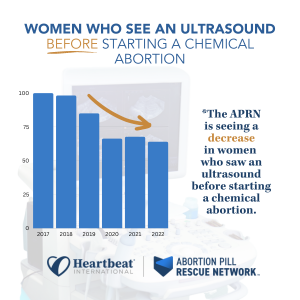
Even when an ultrasound is performed, many women share with APRN nurses that they were not provided the vital information from the scan and do not know if their babies had a heartbeat, the dating of the pregnancy, or if the pregnancy was confirmed to be intrauterine. Because of the failure of the FDA to protect women, there is a gap in information, care, and resources for those considering all options in pregnancy.
Who can be assisted through Pre-Abortion Screening in a pregnancy help medical clinic?
Typically, these appointments are helpful for those who are:
- considering all options for their pregnancies
- scheduling an abortion appointment at an abortion facility, or
- ordering the abortion pill by mail or telehealth
Pregnancy help medical clinics (PHMCs) are in a unique position to offer no-cost medical assessments, safety plans and personal support. Offering a pre-abortion screening is one way to empower women with information about the details of their pregnancies and the choices available to them.
What services are typically included in a pre-abortion screening?
Each center serves its unique community and tailors their services to the needs of the families they serve. Many centers are already offering pre-abortion screenings and have shared that this service is nothing new–just a combination of what they have been doing all along. These clinics offer more choices than abortion facilities and provide concrete solutions to help families overcome barriers to healthy pregnancies.
Care Without Coercion or Cost
PHMCs want families to focus on their own needs, not on how they will pay for care or support. Unlike abortion facilities, PHMCs offer all services without cost to the client. The pre-abortion assessment is an opportunity for a woman considering choices to obtain a free consultation with a licensed healthcare professional who will provide evidence-based information about all her options. Since many women are prescribed the abortion pill with little or no interaction with a healthcare professional, there is immense value in this visit. The PHMC healthcare professional will take the time to answer all the patient’s questions and ensure she makes an informed choice; patients are not pressed to decide for the sake of quick profit.
Confirmation of Pregnancy with A Medical Grade Test
Pregnancy testing is performed by medical professionals, and the results are provided to the patient during the appointment. There are two types of pregnancy tests: a urine sample, and a blood sample. Both pregnancy test types detect the presence of a hormone called human chorionic gonadotropin (hCG). When the preborn baby is implanted in a woman’s uterine lining, hCG hormones begin to develop and multiply. This is a presumptive sign of pregnancy and the PHMC can confirm the patient’s home test results.
Ultrasound Exam for Viability, Dating, And Placement of Pregnancy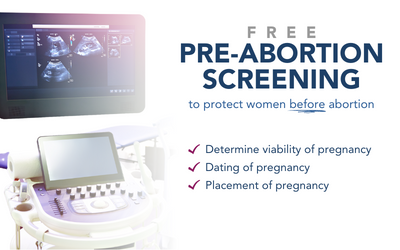
AAPLOG recommends an “ultrasound and exam before medication abortion to confirm gestational age” and that “[to] evaluate for ectopic pregnancy [is] important to maternal safety.” They also confirm that informed consent is a professional obligation, and it would be impossible to tailor counseling about chemical abortion to each patient if an ultrasound were not performed.
Some states require women to have an ultrasound exam before an abortion, but these are becoming fewer and fewer. The frequency of ultrasound by abortion providers decreased during the pandemic when “no touch abortions” were advertised. Now those who sell abortion through telehealth or websites have profited from this omission. However, ultrasound is a common service of PHMCs.
The need for an ultrasound before an abortion is threefold:
- Viability
Mayo Clinic estimates that about 10 to 20 percent of known pregnancies end in miscarriage but states the actual number is likely higher because many miscarriages occur very early in pregnancy. If the baby does not have a heartbeat, there is no need for an abortion. Instead, if the pregnancy is not viable, the patient would be referred to her obstetrician for treatment. - Dating
The American College of Obstetricians and Gynecologists (ACOG) points to research that shows how inaccurate LMP (last menstrual period) dating is, reporting that “in about 40% of pregnancies the LMP is not known or information is not reliable." Accurate confirmation of gestational age with ultrasound measurement reduces the potential for taking medication abortion pills outside of the recommended window. The FDA has approved mifepristone through 10 weeks of pregnancy. Higher gestational age is associated with higher failure rates of medication abortion with failure rates rising after week eight, approaching 7% at 10 weeks, and reaching 40% in the second trimester. - Placement
The FDA warns that a contraindication of mifepristone is a suspected ectopic pregnancy or undiagnosed adnexal mass. Mayo Clinic recommends a transvaginal ultrasound to reveal the exact location of the pregnancy. Women have mistakenly assumed they had an intrauterine pregnancy and attempted, unsuccessfully, to chemically abort. A PHMC can determine if the patient has an intrauterine or ectopic pregnancy.
Blood Type/Rh Factor Testing
The ACOG recommends that “Rh D immune globulin be given to Rh-negative women having any type of abortion.” Yet one-third of Americans do not know their blood type so it would be challenging to do this without testing. The AAPLOG recommends that “all pregnant women undergoing medication abortion or otherwise should be evaluated for Rh status.” PHMCs can offer this simple testing to protect women and future pregnancies from complications.
Mayo Clinic explains that risk occurs when even a small amount of the baby's blood could come in contact with the mother’s blood. This can happen if there is bleeding during pregnancy, such as during a chemical abortion, but can be prevented by Rh testing early in pregnancy.
Health problems usually do not occur during a Rh-negative woman’s first pregnancy with a Rh-positive baby. This is because her body does not have a chance to develop a lot of antibodies. The AAPLOG warns that ignoring these recommendations to test pregnant women before abortion may have significant consequences for future pregnancies.
Rh factor is typically determined with a complete panel during an early prenatal visit but can be performed with a fingerstick using a blood-typing kit in a PHMC.
Hemoglobin Testing
Chemical abortion can cause a significant amount of bleeding and sometimes even hemorrhaging. This extra blood loss increases the risk of blood transfusion for those who are anemic. The Cleveland Clinic explains that iron deficiency is common in pregnancy. The chances of needing a blood transfusion after an abortion are increased if the patient is already anemic.
Anemia during pregnancy, defined as hemoglobin (Hb) < 10.5–11 g/dL, is experienced by as many as 40% of women. Anemia following pregnancy is associated with an increased risk for blood transfusion, postpartum depression, and increased mortality.
The World Health Organization estimates that approximately 27% of maternal deaths are due to obstetric hemorrhages.
Typically a simple fingertip prick can determine iron levels which can be performed in a PHMC setting.
STD Testing
The Centers for Disease Control estimates that one in five people (more than 26 million) in the United States have a sexually transmitted disease. According to the National Library of Medicine, pelvic infection is the most common complication of abortion, and the presence of an existing lower genital tract infection increases the risk of complications. According to this study, women seeking abortion “are at significant risk of harboring sexually transmitted diseases (STDs)” and, when combined with an abortion, can lead to long-term pelvic pain and fertility issues. Since STDs can be asymptomatic, women can reduce their risk of complications after an abortion by testing and obtaining treatment before starting an abortion.
Many centers already offer this service and can include this as part of their pre-abortion screening.
Reversal of Mifepristone (Abortion Pill Reversal™) Information
All women considering abortion should know that their options do not end when they consume the first chemical in an abortion. The possibility exists that she can continue her pregnancy if she has regret after taking mifepristone and help is available 24 hours a day to do so. Abortion pill reversal has a nearly 70% success rate and APRN data shows that more than 4,500 lives have been saved through the APRN. No woman should be forced to complete an abortion she no longer desires, and she must be aware of this possibility before the start of the abortion so she can seek reversal treatment as soon as possible.
Safety Plan Information
Chemical abortion is always self-managed, typically in the home of the patient. Yet abortion with mifepristone and misoprostol has four times the complications of surgical abortion. Patients must determine when bleeding or pain requires urgent medical attention, and oftentimes women are alone in the process. While privacy and the comfort of home might sound appealing as she makes an abortion choice, it can be alarming when emergency care is needed. Before consuming the abortion pill, patients need to consider:
- Who will be present during the abortion process?
- How and where will help be sought in a medical emergency?
- When is urgent care required?
The patient and support person should have a plan for when to obtain urgent care in the days after the abortion. She should seek medical attention right away if she has:
- a fever of 100.4°F or higher that lasts for more than four hours
- severe abdominal pain
- heavy bleeding (soaking through two thick, full-size sanitary pads per hour for two hours in a row), or
- stomach pain or discomfort including weakness, nausea, vomiting, or diarrhea, for more than 24 hours after taking misoprostol
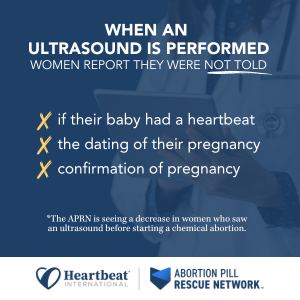 Having a plan in place before consuming abortion drugs is essential to ensure safety. The AAPOG states that “chemical abortion is contraindicated if there is no access to medical facilities for emergency services” under the black box warning assigned.
Having a plan in place before consuming abortion drugs is essential to ensure safety. The AAPOG states that “chemical abortion is contraindicated if there is no access to medical facilities for emergency services” under the black box warning assigned.
At the emergency department, the patient must explain what medications she has consumed and her precise symptoms. If available, the FDA advises the patient to take the Medication Guide for Mifeprex when seeking medical care so that it can be readily understood that she is undergoing a chemical abortion.
A follow-up plan should be made with a trusted healthcare provider about 7 to 14 days after taking the abortion pills to be sure that the abortion is complete and there are no complications that could lead to infection and hemorrhage. PHMCs have referrals for trusted obstetricians in their communities that can ensure the well-being of these patients following an abortion.
Why are PHMCs the place for pre-abortion screenings?
In every pregnancy, there are two patients: two lives, two heartbeats, and two sets of DNAs. Pre-abortion screening enables PHMCs to care for and protect both patients.
PHMCs advocate for women, not just before the choice is made but afterward, too. Sometimes the answers are not a “quick fix,” and the road to a pregnancy decision may require time and tangible assistance. PHMCs ensure the long-term well-being of their patients and their children and understand that the answer to an unexpected pregnancy is not a “quick fix” that the abortion industry promotes.
___________________________________________________________________________________________________________________________
If your center wants assistance or has questions regarding these services, please contact our Medical Impact team at This email address is being protected from spambots. You need JavaScript enabled to view it..
The Golden Ticket to Financial Resilience
Presented by Valerie Harkins, Housing Specialist
The pandemic showed us just how delicate our fundraising strategies are to unforeseen events. Many nonprofits found themselves financially vulnerable in 2020 without the ability to host their annual fundraising events or apply for a specific grant upon which they had become reliant. It’s been three years since then, and the trends have continued to speak a sobering message.
Fundraising trends are on the move in 2023. With the turbulence of the economy, the unpredictability of the environment, the shift in the generation of the primary donor base, and adjustments to the new post-pandemic norms, homes are finding that—now more than ever— they have a critical need for diversified revenue streams. Overall, we have seen a national increase in donations; however, this has been matched with an even greater decrease in purchasing power, frequently resulting in a realistic net loss for organizations. As is common during times of economic hardship, the number of individual donors on average has decreased with an increased amount per monetary contribution made. This means we have fewer people making contributions but larger individual contributions, creating an elusive financial projection that appears strong at the bottom line but is built upon what is likely akin to a Jenga tower.
Financial resilience is the golden ticket to stability in this season. This necessitates fundraising strategies built upon multiple revenue streams. A personal recommendation is to maintain an average of five sources of income. This provides you with a broad donor base and the gift of time when catastrophe strikes. Examples include minor events, major events, monthly donors, and grants. To learn more, check out our webinar Diversifying Your Home’s Revenue Streams where we take a deep dive into this topic. And there is no time like the present to strengthen your funding strategy by getting in on the Development Tack at Pregnancy Help Institute. There’s still time!


